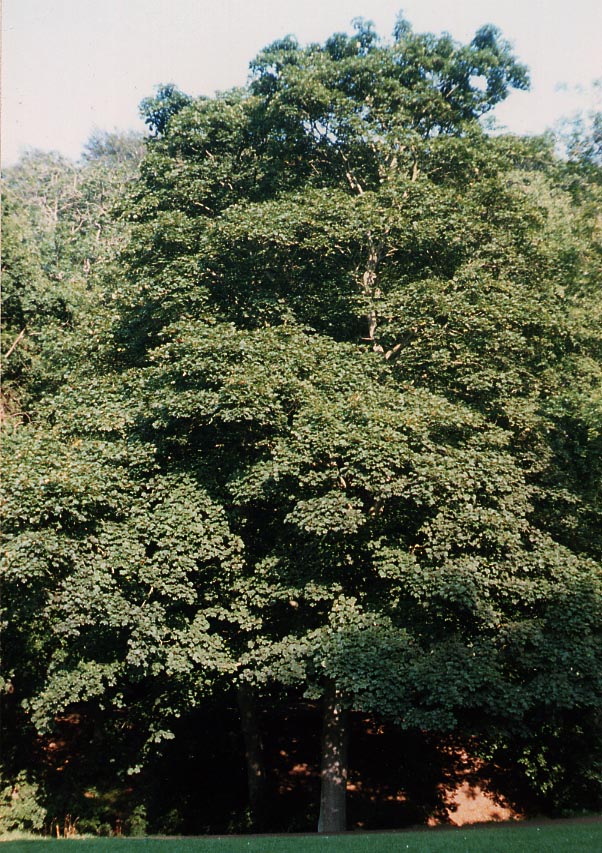- Acer pseudoplatanus
taxobox
name = "Acer pseudoplatanus"
image_caption = Sycamore Maple leaves
regnum =Plantae
unranked_divisio =Angiosperms
unranked_classis =Eudicots
unranked_ordo =Rosids
ordo =Sapindales
familia =Sapindaceae
genus = "Acer"
species = "A. pseudoplatanus"
binomial = "Acer pseudoplatanus"
binomial_authority = L.|"Acer pseudoplatanus" (Sycamore or Sycamore Maple to distinguish it from other plants called
sycamore ) is a species ofmaple native to centralEurope and southwesternAsia , fromFrance east toPoland , and south in mountains to northernSpain , northernTurkey , and theCaucasus .Flora Europaea: [http://rbg-web2.rbge.org.uk/cgi-bin/nph-readbtree.pl/feout?FAMILY_XREF=&GENUS_XREF=Acer&SPECIES_XREF=pseudoplatanus&TAXON_NAME_XREF=&RANK= "Acer pseudoplatanus"] ] Rushforth, K. (1999). "Trees of Britain and Europe". Collins ISBN 0-00-220013-9.]Description
It is a large
deciduous tree that reaches 20–35 m tall at maturity, with a broad, domed crown. On young trees, thebark is smooth and grey but becomes rougher with age and breaks up in scales, exposing the pale-brown-to-pinkish inner bark. The leaves are opposite, 10-25 cm long and broad with a 5-15 cm petiole, palmately-veined with five lobes with toothed edges, and dark green in colour; somecultivar s have purple-tinged or yellowish leaves. The monoecious yellow-greenflower s are produced in spring on 10-20 cm pendulousraceme s, with 20-50 flowers on each stalk. The 5-10 mm diameterseed s are paired in samaras, each seed with a 20-40 mm long wing to catch the wind and rotate when they fall; this helps them to spread further from the parent tree. The seeds are mature in autumn about 6 months after pollination.Humphries, C. J., Press, J. R., & Sutton, D. A. (1992). "Trees of Britain and Europe". Hamlyn Publishing Group Ltd. ISBN 0-600-57511-X.]A number of species of
Lepidoptera use the leaves as a food source; see Lepidoptera that feed on maples.The name "sycamore" originally belongs to the
fig species "Ficus sycomorus " native to southwestAsia (this is the sycamore or sycomore referred to in theBible ), and was later applied to this species (and others; see also "Platanus ") by reason of the superficial similarity in leaf shape.Cultivation and uses
It is noted for its tolerance of wind, urban
pollution and salt spray, which makes it a popular tree for planting in cities, alongroad s treated with salt in winter, and incoast al localities. It is cultivated and widely naturalised north of its native range in northern Europe, notably in theBritish Isles andScandinavia north toTromsø ,Norway (can ripen seeds north toVesterålen );Reykjavík ,Iceland ; andTorshavn on theFaroe Islands . It now occurs throughout theBritish Isles , having been introduced in the 17th century [Preston, Pearman & Dines. (2002). "New Atlas of the British Flora". Oxford University Press.]In
North America , escapes from cultivation are most common inNew England ,New York City and thePacific Northwest . It is planted in many temperate parts of theSouthern Hemisphere , most commonly inNew Zealand and on theFalkland Islands . It is considered an environmental weed in some parts of Australia (Yarra Ranges, Victoria). [ [http://www.parkweb.vic.gov.au/resources/mresources/publications/03_weeds_pests.pdf Environmental weeds] ]The popular cultivar 'Brilliantissimum' is notable for the bright salmon-pink colour of the young foliage.
It is planted for
timber production; thewood is white with a silky lustre, and hard-wearing, used formusical instrument making,furniture ,wood flooring andparquetry . Occasional trees produce wood with a wavy grain, greatly increasing the value for decorativeveneer s. It is a traditional wood for use in making the backs, necks and scrolls of violins.The flowers produce abundant nectar, which makes a fragrant, delicately flavoured and pale-coloured honey.
References
Gallery: Stages in opening leaf buds
Wikimedia Foundation. 2010.
